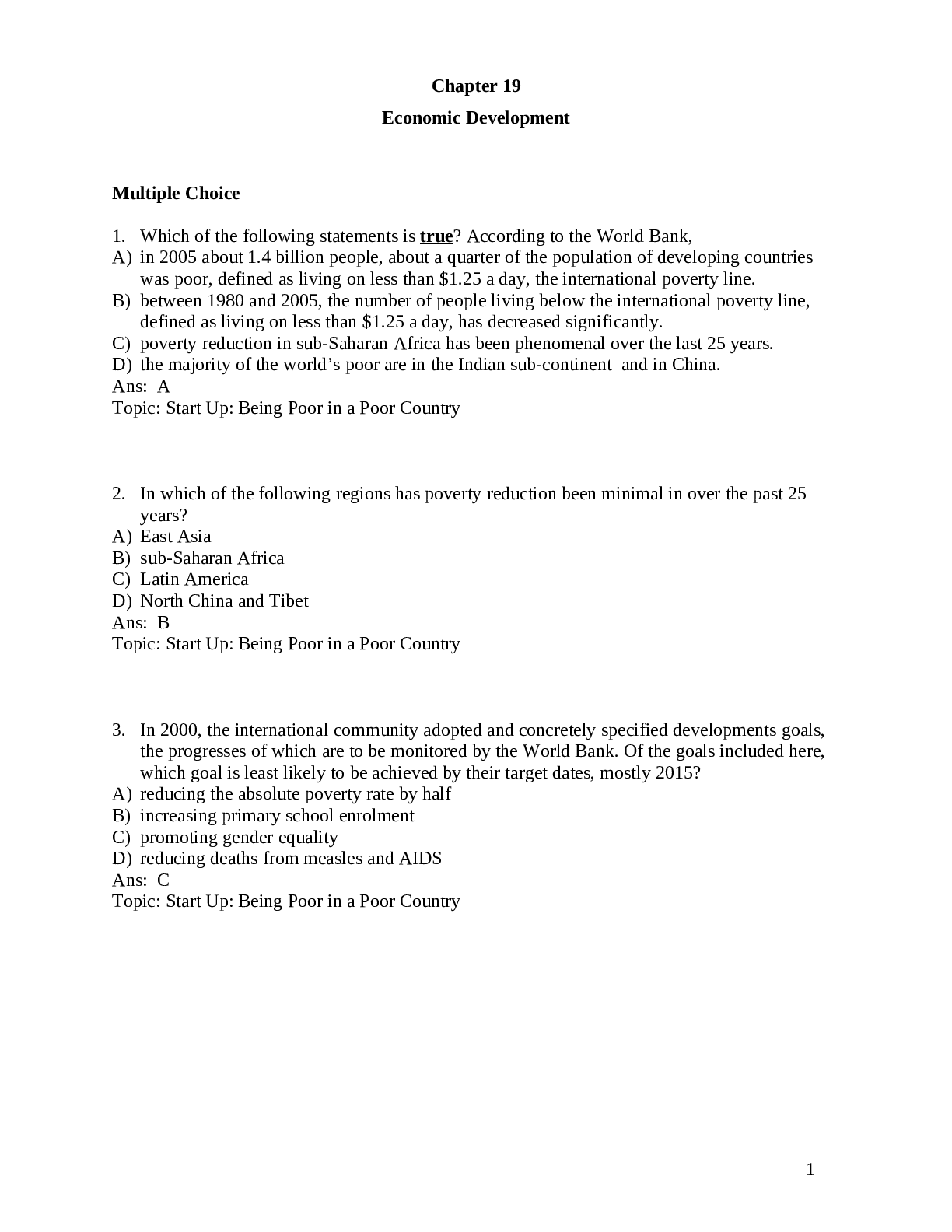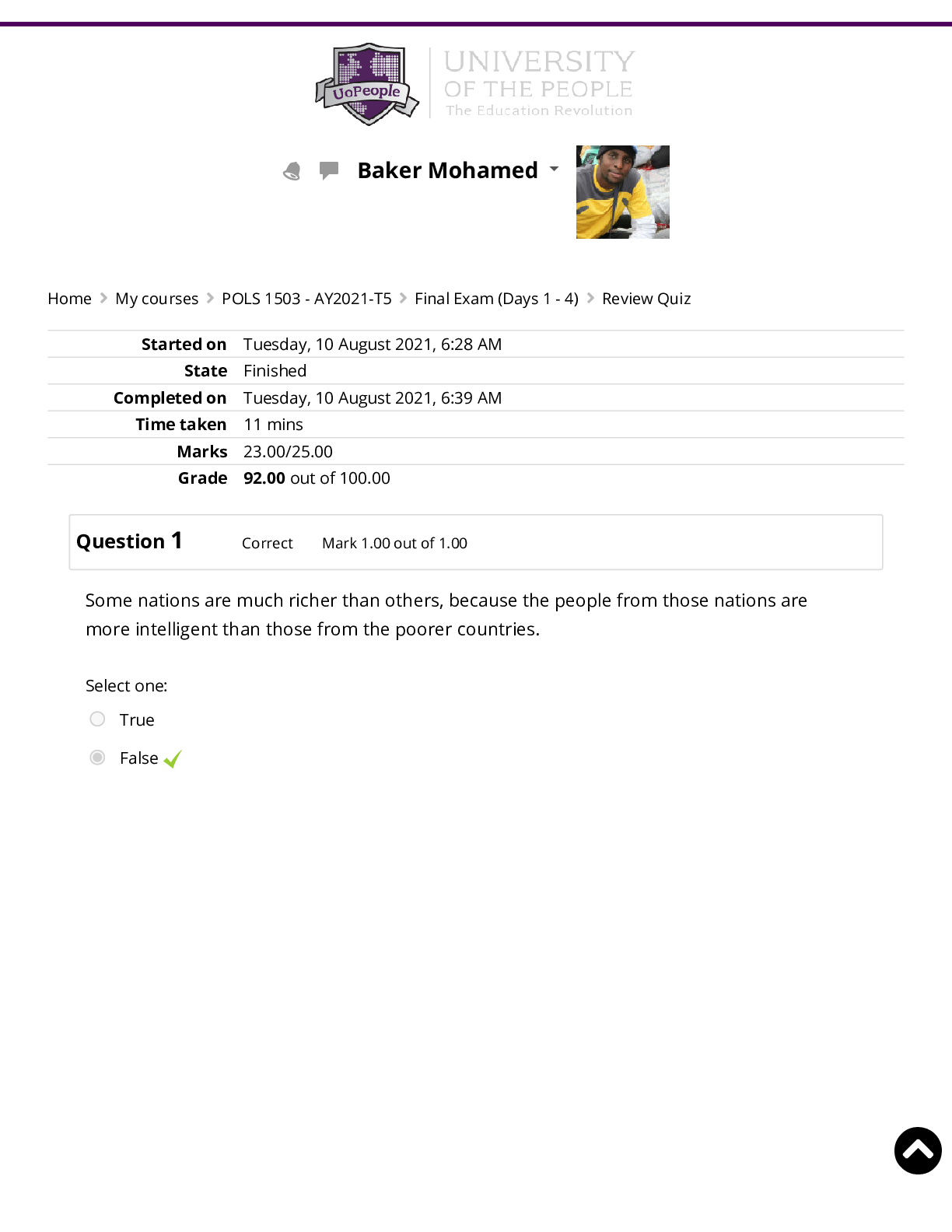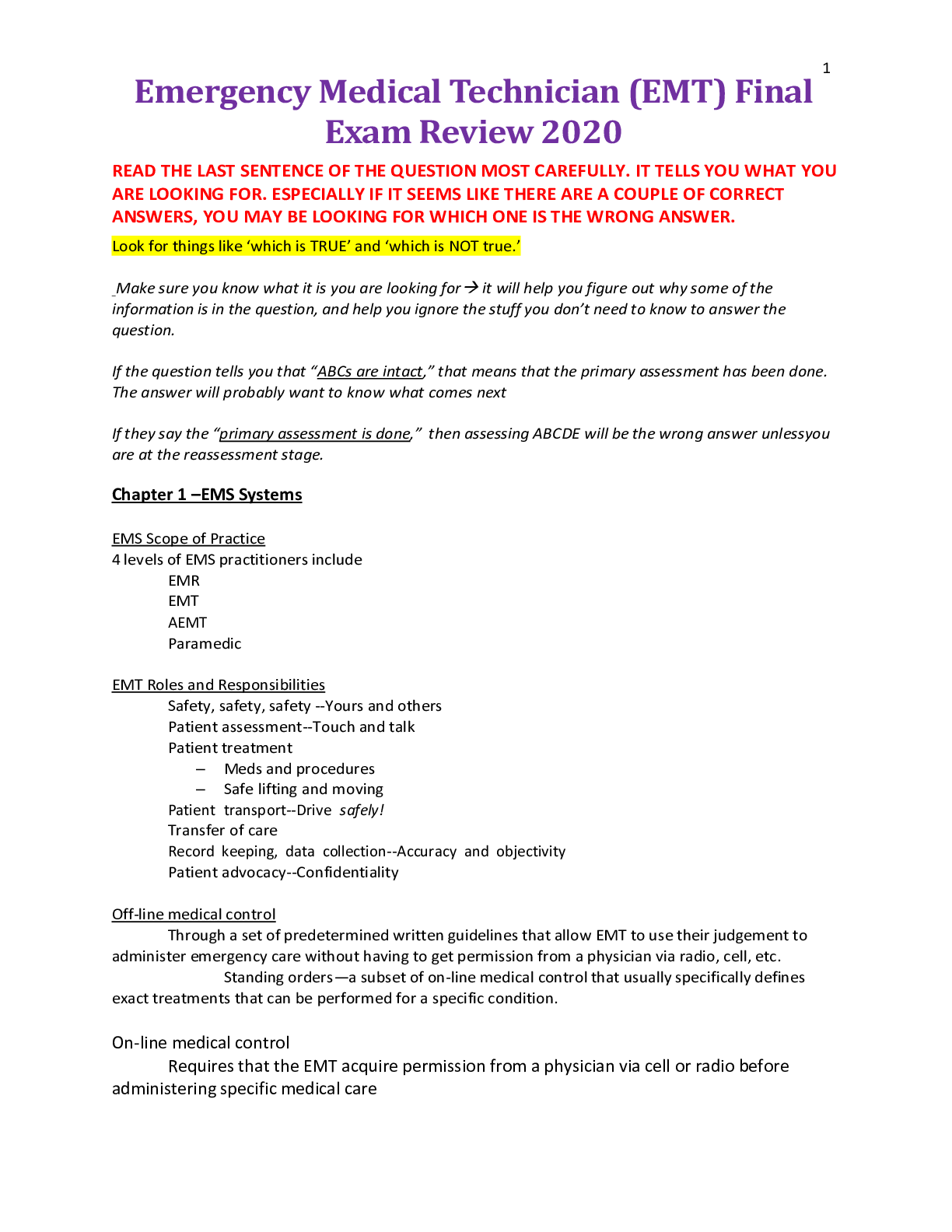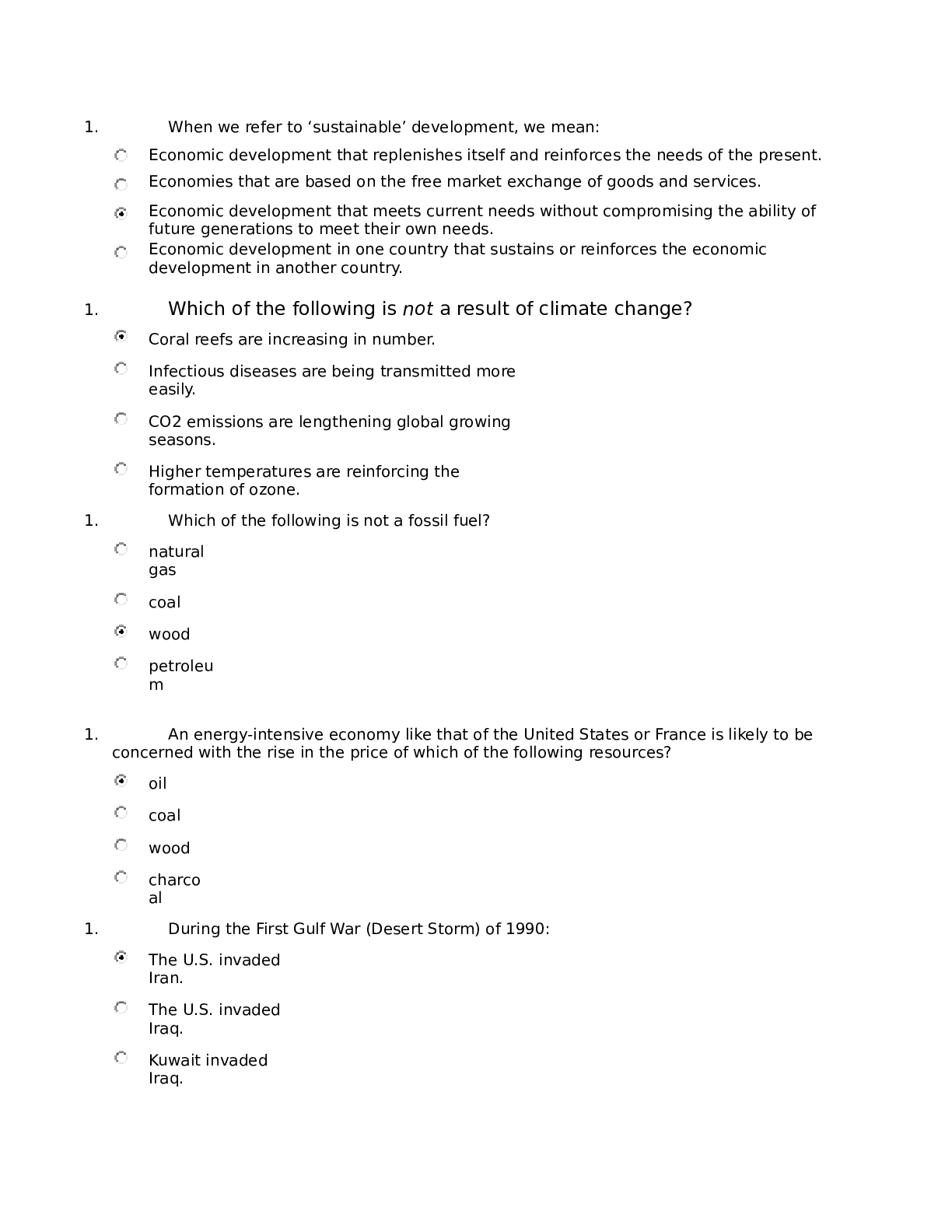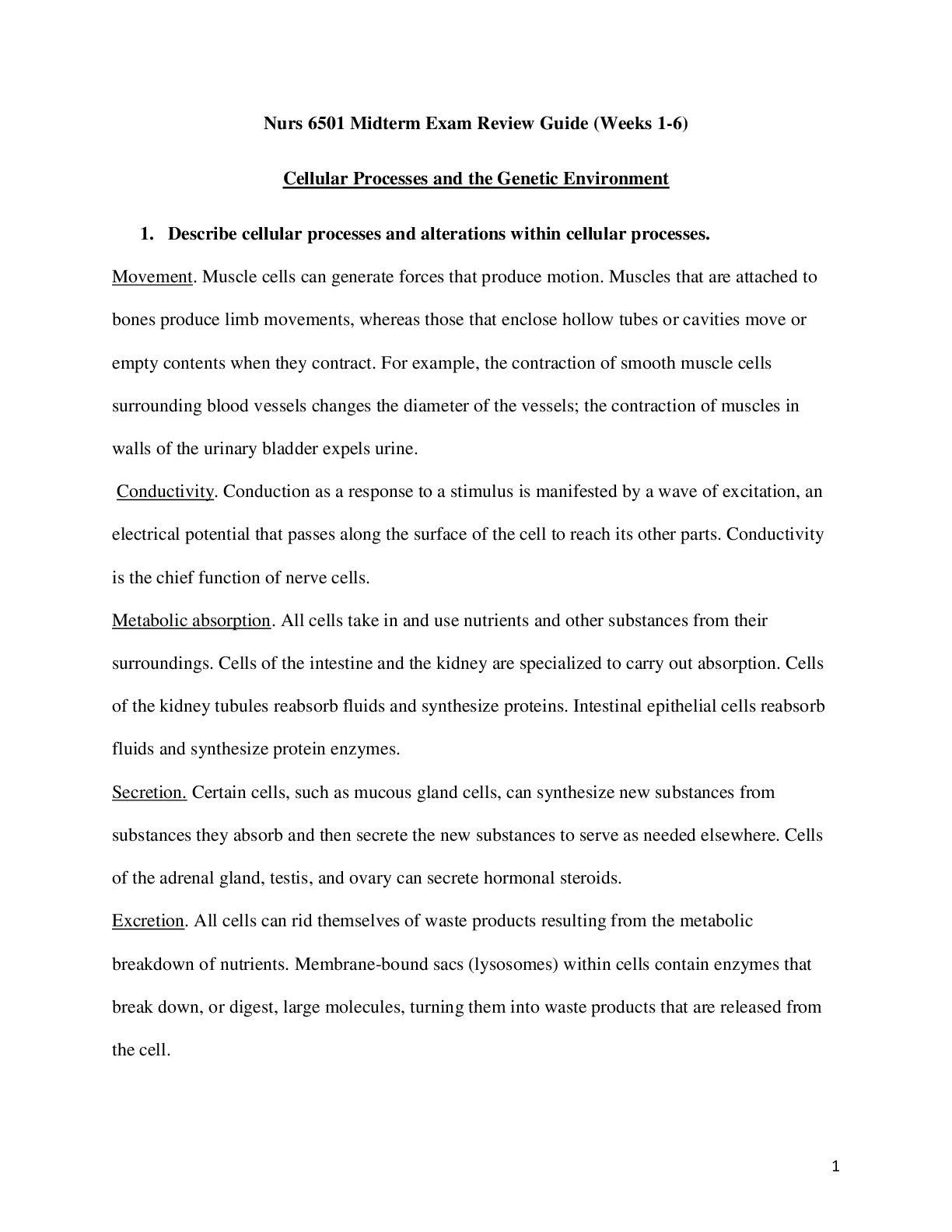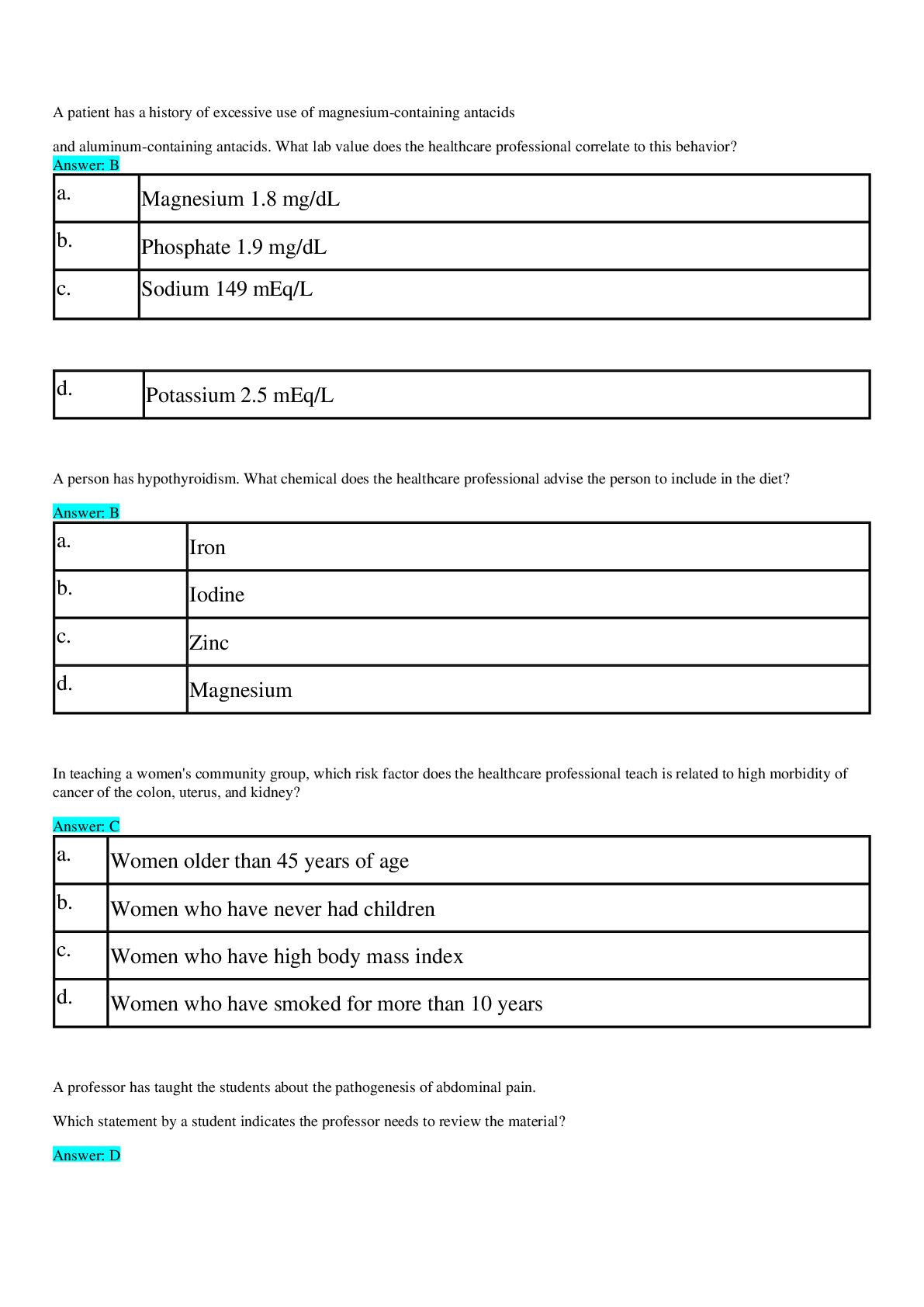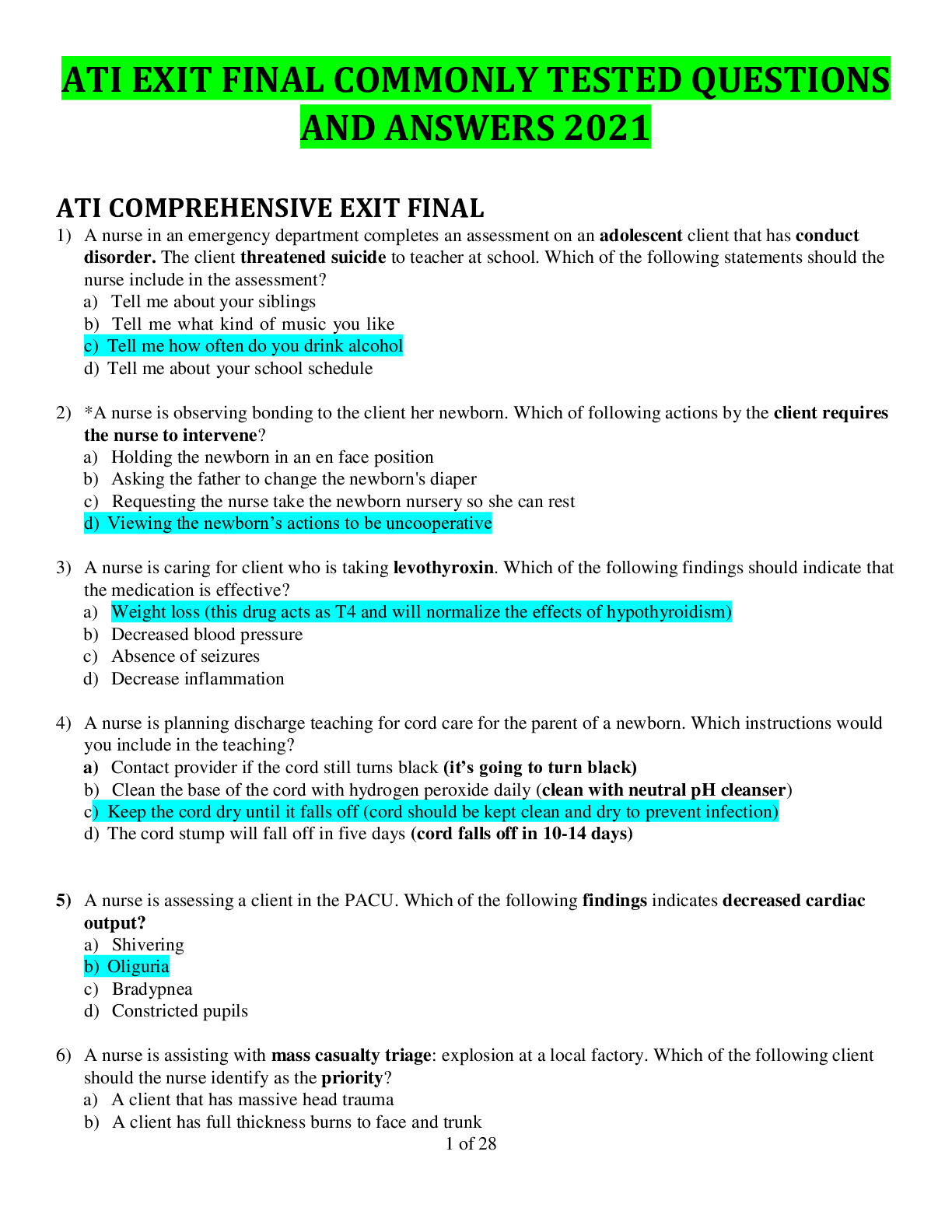*NURSING > EXAM REVIEW > Walden University - NURS 6501 FINAL TEST PREP/ ALL Nursing Final Test Preparation Document. Has 352 (All)
Walden University - NURS 6501 FINAL TEST PREP/ ALL Nursing Final Test Preparation Document. Has 352 pages containing, all (2000+) commonly and rarely tested questions and Answers. Etremely essential materials for quick exam readiness..
Document Content and Description Below
HERE ARE SAMPLE QUESTIONS AND ANSWERS CONTAINED IN THE FIRST 50 PAGES ALONE. 6501 FINAL TEST PREP CHAPTER 32 1. A nurse recalls the major hormonal determinant of sexual differentiation in utero i... s: a. Estrogen b. Progesterone c. Growth hormone d. Testosterone d 2. A nurse is preparing to teach about puberty. Which information should the nurse include? One substance associated with puberty in males and females is the hormone: a. Follicle-stimulating hormone (FSH) b. Luteinizing hormone (LH) c. Leptin d. Estrogen c 3. A nurse is discussing female anatomy. Which body structure contains the openings to the vagina and urinary meatus? a. Vestibule b. Mons pubis c. Introitus d. Perineal body a 4. While preparing to teach the staff about female anatomy, which information should be included? During the years that a woman is more likely to be sexually active, the vagina mucosa is protected from infection by: a. Presence of autoantibodies b. An acidic pH c. bLow estrogen levels d. Douching 5. When a staff member asks the nurse what the thick middle layer of the uterine wall is called, what is the nurse's best response? The: a. Epithelial layer b. Endometrium c. Myometrium d. Perimetrium c 6. A nurse recalls the _____ is lined with columnar epithelial cells. a. Perimetrium b. Endocervical canal c. Myometrium d. Vagina b 7. A nurse is preparing to teach about female anatomy. Which information should the nurse include? The female erectile organ that secretes smegma is called the: a. Introitus b. Bartholin glands c. Clitoris d. Labia minora c 8. A nurse is teaching about the menstrual cycle. Spinnbarkeit mucus is present during which stage of the menstrual cycle? a. Follicular b. Ovulation c. Luteal d. Menstrual b9. When the nurse describes the duct that carries the ovum from the ovary to the uterus, what is the nurse discussing? The: a. Isthmus b. Corpus c. Endocervical canal d. Fallopian tube d 10. A nurse is teaching the staff about female hormones. Which hormone promotes the formation of channels in the mucus of the cervical os to facilitate sperm movement into the uterus? a. LH b. FSH c. Progesterone d. Estrogen d 11. When a patient who is trying to get pregnant asks where the usual site of fertilization is, how should the nurse respond? The: a. Uterus b. Fimbriae c. Ampulla of the fallopian tubes d. Os of the fallopian tubes c 12. A nurse is teaching about the female anatomy. Which information should the nurse include? Cells of the ____ have receptors for gonadotropins. a. Uterus b. Breast c. Ovary d. Vagina c 13. The nurse is preparing to teach the staff about female anatomy. Which information bshould the nurse include? The ova are contained within the ovarian: a. Corpus luteum b. Follicle c. Stroma d. Infundibulum 14. Which information indicates the nurse has a good understanding of female anatomy? Having ejected a mature ovum, the ovarian follicle then develops into: a. An atretic follicle b. A theca cell c. A corpus luteum d. Scar tissue c 15. When a staff member asks the nurse what is the most potent of the following estrogens, what is the nurse's best response? It is: a. Estradiol b. Testosterone c. Estrone d. Estriol a 16. Which information indicates the nurse has a good understanding of progesterone? Progesterone is primarily secreted by the: a. Follicle b. Corpus luteum c. Granulose cells d. Anterior pituitary b 17. A 56-year-old female is in menopause. She has ovarian failure. While checking the lab results, which of the following will the nurse find? a. aIncreased FSH b. Increased estrogen c. Decreased GnRH d. Decreased LH 18. Progesterone is often referred to as "the hormone of pregnancy," and the patient asks what this phrase means. How should the nurse respond? Progesterone is the hormone of pregnancy because it: a. Stimulates lactation b. Increases ciliary action in the fallopian tubes c. Thins the endometrium d. Prevents smooth muscle contraction of the uterus d 19. When the nurse is teaching about the menstrual cycle, which information should be included? Menstruation is followed by the _____ phase of the menstrual cycle. a. Follicular b. Luteal c. Secretory d. Ischemic a 20. Which information indicates the nurse has a good understanding of the menstrual cycle? When estrogen and progesterone levels drop, the endometrium enters the _____ phase. a. Proliferative b. Luteal c. Menstrual d. Recovery c 21. A staff member asks the nurse when ovulation occurs. What is the nurse's best response? During the menstrual cycle, ovulation occurs when: a. bThere is a gradual decrease in estrogen levels. b. Inhibin B sharply spikes. c. A surge in progesterone occurs. d. Activin is released. 22. A nurse remembers the LH surge transforms granulosa cells into: a. Theca cells b. Corpus luteal cells c. Ova d. Fibroblasts b 23. A nurse is teaching about female hormones. Which information should the nurse include? Endometrial thickening during the proliferative phase is stimulated by increased levels of: a. Estrogen b. Progesterone c. FSH d. Inhibin a 24. A student asks the instructor which of the following hormones stimulates follicular maturation. How should the instructor respond? a. Activin b. Inhibin c. LH d. Follistatin a 25. Changes in the cervical mucus can be used to identify the periods in which a female is most fertile. How should the nurse describe cervical mucus during ovulation? a. Blood-tinged b. dThin and watery c. Absent d. Abundant and elastic 26. A clinician is preparing to teach about spermatogenesis. Which information should the clinician include? Spermatogenesis occurs in the: a. Epididymis b. Inguinal canals c. Seminiferous tubules d. Vas deferens c 27. When a nurse is describing the male anatomy, which paired glands lie posterior to the urinary bladder in the male? a. Seminal vesicles b. Prostate glands c. Cowper glands d. Parabladder glands a 28. A patient asks the nurse what is the most sensitive area of the penis. What is the nurse's best answer? The area of the penis with the most nerve endings is the: a. Foreskin b. Glans c. Corpora cavernosa d. Corpus spongiosum b 29. What term should the nurse use when discussing male sex hormones collectively? a. Gonadotropins b. Testosterones c. Catabolic steroids dd. Androgens 30. When discussing the difference between male and female sex hormones, which information should the nurse include? The major difference between male and female sex hormone production is that: a. LH has no apparent action in the male. b. Sex hormone production in the male is relatively constant. c. Estrogen is not produced in the male. d. In the male, GnRH does not cause the release of FSH. b 31. A nursing student asks the nurse where the glands of Montgomery are located. How should the nurse reply? The glands of Montgomery are located in the: a. Testes b. Breasts c. Uterus d. Vagina b 32. When a staff member asks which structure secretes glucose-rich fluid into the semen, how should the nurse respond? a. Seminal vesicles b. Ejaculatory duct c. Prostate gland d. Cowper gland a 33. When a teenager asks what makes the breast grow, what is the nurse's best response? The hormone that promotes breast development during puberty is: a. Progesterone b. Prolactin c. Oxytocin d. dEstradiol 34. When a breastfeeding mom asks what causes letdown, which information should the nurse give the patient? The hormone that plays a role in breast milk ejection (letdown) during lactation is: a. Cortisol b. Prolactin c. Oxytocin d. Progesterone c 35. While speaking to a group of older males, which information should the nurse share? The following is a normal characteristic of aging and the male reproductive system: a. Changes in libido are not related to health status. b. Tissue responsiveness to testosterone is increased. c. Testicles will hypertrophy. d. Refractory time after ejaculation is prolonged. d 36. The nurse is discussing information about menopause with an older woman. Which of the following characteristics are associated with declining ovarian function with age? (Select all that apply.) a. Vasomotor flush b. Decline in bone mass c. Decreased risk of coronary disease d. Atrophy of the uterus e. Dysfunctional uterine bleeding a,b,d,e 37. A 25-year-old female has a menstrual cycle of 28 days' duration and asks the nurse what day of the cycle will ovulation occur. The nurse responds that ovulation will occur on day _____. 14 CHAPTER 33 1. The descent of the bladder and the anterior vaginal wall into the Cystocelevaginal canal is called a _____. 2. Which of the following signs is usually the first clinical manifestation of breast cancer? a painless lump 3. A 35-year-old nonpregnant female presents with breast discharge and is diagnosed with galactorrhea. The condition is most likely caused by _____. Prolactin imbalance 4. During a routine pelvic exam, a 34-year-old female is found to have an ovarian cyst containing skin, hair, cartilage, and bone. This cyst is classified as a _____ cyst. Dermoid 5. A 35-year-old female is diagnosed with ovarian cancer. CT scan reveals that the cancer is limited to the ovaries. It would be classified as stage _____. I 6. A 21-year-old female is infected with human papillomavirus (HPV) following unprotected sexual intercourse with a male she recently met. She is now at higher risk of developing which of the following cancers? cervical 7. A 25-year-old female presents with amenorrhea and hirsutism and is diagnosed with polycystic ovary syndrome (PCOS). Lab testing will most likely reveal _____. Hyperinsulinemia 8. The most commonly occurring cancer of the female reproductive tract is _____ cancer. Endometrial 9. A 38-year-old female was recently diagnosed with cancer. She learns that her mother almost miscarried while pregnant with her and was given diethylstilbestrol (DES) to prevent it. Which of the following cancers does she most likely have? Vaginal 10. A 20-year-old female presents with pelvic and back pain severe enough to miss work beginning with the onset of menses. Physical examination supports the diagnosis of primary dysmenorrhea. The most likely cause of her condition is _____. elevated prostaglandins 11. An 18-year-old female is diagnosed with dysmenorrhea. Which of the following symptoms will she most likely experience? Painful menstruation 12. A 30-year-old female with newly diagnosed polycystic ovary syndrome (PCOS) is being counseled by her OB-GYN. The physician indicates that this condition often results in _____. Infertility 13. A 40-year-old female presents with cramping and excessive vaginal bleeding. Ultrasound reveals benign uterine tumors in the smooth muscle cells of the myometrium. These tumors are commonly called _____. Leiomyomas 14. A 23-year-old sexually active female presents with white copious Candida albicansdischarge and itch and is diagnosed with yeast vaginitis. This condition is caused by overgrowth of which micro-organism? 15. A 35-year-old female is diagnosed with endometriosis. Suppressing which of the following would be the most appropriate medical treatment for this disease? Ovulation 16. The nurse would anticipate the treatment for pelvic organ prolapse to be _____. A pessary CHAPTER 34 1. A 21-year-old presents with inflammation of the testes and is diagnosed with orchitis. What is the most likely cause of his symptoms? A. Herpes virus. B. Escherichia coli. C. Mumps. D. Cytomegalovirus. C. Mumps 2. A common complaint from men with mild to moderate benign prostatic hypertrophy (BPH) is _____. A. Decreased urinary stream. B. Infertility. C. Sexual dysfunction. D. Prostatodynia. A. Decreased urinary stream 3. A 30-year-old presents with penile tenderness and discharge while the physical examination reveals that his foreskin cannot be retracted back of the glans penis. This assessment data is consistent with what condition? A. Paraphimosis. B. Phimosis. C. Peyronie disease. D. Priapism. B. Phimosis 4. A 35-year-old presents with symptomology that is associated with syphilis. What organism is responsible for the development of syphilis? A. Treponema pallidum. B. Chlamydia trachomatis. C. Neisseria gonorrhoeae. D. Haemophilus ducreyi. A. Treponema pallidum5. _____ is an inflammation of the glans penis. A. Phimosis. B. Balanitis. C. Priapism. D. Hydrocele. B. Balanitis 6. Cryptorchidism can be defined as _____. A. A normal development state of the testes. B. An abnormal state in which the testes are overdeveloped. C. Lack of a scrotum. D. Problems with testicular descent. D. Problems with testicular descent 7. A 38-year-old presents reporting difficulty having sexual intercourse because his penis bends during erection. What term describes this condition? A. Phimosis. B. Cryptorchidism. C. Paraphimosis. D. Peyronie disease. D. Peyronie disease 8. An example of a parasitic sexually transmitted infection (STI) that is transmitted through close skin-to-skin contact is _____. A. Chlamydia. B Syphilis. C. Scabies. D. Gardnerella. C. Scabies 9. A 25-year-old sexually active male presents with urethritis and epididymitis, and is diagnosed with the most common bacterial STI in the United States. What is this infection? A. Gonorrhea. B. Syphilis. C. Chlamydia. D. Herpes. C. Chlamydia 10. Symptoms of acute bacterial prostatitis are similar to symptoms of _____. A. Prostate cancer. B. Benign prostatic hypertrophy (BPH). C. Urinary tract infection (UTI). D. Epididymitis. C. Urinary tract infection (UTI)11. An important factor in the development of benign prostatic hypertrophy (BPH) among Americans is _____. A. Recurrent prostatitis. B. A diet high in fat. C. Cigarette smoking. D. Increased age. D. Increased age 12. In the majority of cases delayed puberty is due to _____. A. A disruption in the hypothalamus. B. A disruption in the pituitary. C. Slow maturation D. Ambiguity in sex determination. C. Slow maturation 13. The patient's medication has a side effect of gynecomastia. The nurse would respond that gynecomastia is _____. A. Lack of breast development in women. B. Overdevelopment of breast tissue in males. C. A type of breast cancer. D. Inflammation of the mammary glands. B. Overdevelopment of breast tissue in males Question 1 1 out of 1 points A 15-year-old female presents with flank pain, irritability, malaise, and fever. Tests reveal glomerulonephritis. When the parents ask what could have caused this, how should the nurse respond? Selected Answer: a. Poststreptococcal infection Correct Answer: a. Poststreptococcal infection Question 2 1 out of 1 points When a child is admitted with acute renal failure, a clinician realizes the most common cause of acute renal failure is: Selected Answer: d. Hemolytic uremic syndrome (HUS) Correct Answer: d. Hemolytic uremic syndrome (HUS) Question 3 1 out of 1 points A 35-year-old hypertensive male begins taking a diuretic. Which of the following common side effects of this medication should the nurse monitor? Selected Answer: a. Hypokalem ia Correct Answer: a. Hypokalem ia Question 4 1 out of 1 points A 30-year-old male is demonstrating hematuria with red blood cell casts and proteinuria exceeding 3 to 5 g/day, with albumin being the major protein. The most probable diagnosis the nurse will see documented on the chart is: Selected Answer: c. Acute glomerulonephritis Correct Answer: c. Acute glomerulonephritis Question 5 1 out of 1 points A 7-year-old male presents to his primary care provider for incontinence. His mother indicates that he has never been continent. Which of the following is the most likely diagnosis the nurse will observe on the chart? Selected Answer: c. Primary enuresis Correct Answer: c. Primary enuresis Question 6 1 out of 1 points A 5-year-old male was diagnosed with glomerulonephritis. History reveals that he had an infection 3 weeks before the onset of this condition. The infection was most likely located in the: Selected Answer: c. Respiratory tractCorrect Answer: c. Respiratory tract Question 7 1 out of 1 points A 42-year-old female is diagnosed with chronic renal failure, and the nurse is discussing dietary treatment. Which information indicates the nurse understands dietary regimen? Treatment includes restricting: Selected Answer: c. Protein s Correct Answer: c. Protein s Question 8 1 out of 1 points A urologist is discussing the phagocytic cells that lie between the layers of the renal corpuscle. What is the urologist describing? Selected Answer: c. Mesangial cells Correct Answer: c. Mesangial cells Question 9 1 out of 1 points When a newborn is admitted with urinary tract infections (UTIs), which type of infection will the nurse look for in the newborn? Selected Answer: b. Infections caused by bacteria from the gastrointestinal (GI) tract Correct Answer: b. Infections caused by bacteria from the gastrointestinal (GI) tract Question 10 1 out of 1 points A nurse is reviewing urinalysis results and notices glucose is present in the urine. A nurse realizes glucose will be excreted in the urine when: Selected Answer: b. The carrier molecules have reached their maximumCorrect Answer: b. The carrier molecules have reached their maximum Question 11 1 out of 1 points A 25-year-old female presents with burning urination. She was diagnosed with a urinary tract infection. When the nurse checks the culture results, which of the following organisms is most likely infecting her urinary tract? Selected Answer: d. Escherichia coli Correct Answer: d. Escherichia coli Question 12 1 out of 1 points A 45-year-old female presents with hypertension, anorexia, nausea and vomiting, and anemia. She is diagnosed with chronic renal failure. When the patient asks what caused this anemia, how should the nurse respond? Your anemia is caused by: Selected Answer: b. Inadequate production of erythropoietin Correct Answer: b. Inadequate production of erythropoietin Question 13 1 out of 1 points A 35-year-old female was severely burned and is hospitalized. She is now suffering from acute tubular necrosis (ATN). Which of the following is the most likely diagnosis the nurse will observe on the chart? Selected Answer: b. Intraren al Correct Answer: b. Intraren al Question 14 1 out of 1 points A nurse is preparing to teach about the loop of Henle. Which information should be included? The descending segment of the loop of Henle primarily allows for:Selected Answer: d. Water reabsorption Correct Answer: d. Water reabsorption Question 15 1 out of 1 points Anemia accompanies chronic renal failure because of: Selected Answer: c. Inadequate production of erythropoietin Correct Answer: c. Inadequate production of erythropoietin Question 16 1 out of 1 points A 3-year-old female presents with recurrent urinary tract infections (UTIs), fever, poor growth and development, and feeding problems. Tests reveal a retrograde flow of urine from the urinary bladder into the ureters. When giving report to the oncoming shift, the nurse will call this condition: Selected Answer: a. Vesicoureteral reflux (VUR) Correct Answer: a. Vesicoureteral reflux (VUR) Question 17 1 out of 1 points A 42-year-old male is involved in a motor vehicle accident during which he loses a lot of blood. The nurse realizes he is in acute renal failure caused by: Selected Answer: c. Inadequate renal blood flow Correct Answer: c. Inadequate renal blood flow Question 18 1 out of 1 points While turning a patient with chronic renal failure, which principle should the nurse recall? Bone fractures are a risk factor in chronic renal failurebecause: Selected Answer: c. The kidneys fail to activate vitamin D. Correct Answer: c. The kidneys fail to activate vitamin D. Question 19 1 out of 1 points While planning care for a patient who has acute pyelonephritis. A nurse recalls the most common condition associated with the development of acute pyelonephritis is: Selected Answer: c. Urinary tract obstruction Correct Answer: c. Urinary tract obstruction Question 20 1 out of 1 points A 75-year-old male reports to his primary care provider loss of urine with cough, sneezing, or laughing. Which of the following is the most likely diagnosis the nurse will observe on the chart? Selected Answer: b. Stress incontinence Correct Answer: b. Stress incontinence Question 21 1 out of 1 points A 2-year-old male is diagnosed with Wilms tumor. Which of the following clinical conditions is often associated with this disease? Selected Answer: b. Aniridi a Correct Answer: b. Aniridi a Question 22 1 out of 1 points When the nurse is discussing the sodium-sensing cells of the glomerulus,what term should the nurse use? Selected Answer: b. Macula densa Correct Answer: b. Macula densa Question 23 1 out of 1 points When describing the male urinary anatomy, which information should the nurse include? The portion of the male urethra that is closest to the bladder is the _____ portion. Selected Answer: b. Prostati c Correct Answer: b. Prostati c Question 24 1 out of 1 points If a nurse wants to obtain the best estimate of renal function, which test should the nurse monitor? Selected Answer: a. Glomerular filtration rate (GFR) Correct Answer: a. Glomerular filtration rate (GFR) Question 25 1 out of 1 points A nurse observes on the chart that a patient is admitted with Wilms tumors. A nurse knows the tumors are found in the: Selected Answer: a. Kidney s Correct Answer: a. Kidney s Question 26 1 out of 1 points On average the kidneys receive approximately _____ of the cardiac output.Selected Answer: c. 20% to 25% Correct Answer: c. 20% to 25% Question 27 1 out of 1 points The urologist is teaching about the nephrons that determine the concentration of the urine. The urologist is discussing the _____ nephrons. Selected Answer: a. Juxtamedull ary Correct Answer: a. Juxtamedull ary Question 28 1 out of 1 points A 27-year-old male has a severe kidney obstruction leading to removal of the affected kidney. Which of the following would the nurse expect to occur? Selected Answer: b. Compensatory hypertrophy of the remaining kidney Correct Answer: b. Compensatory hypertrophy of the remaining kidney Question 29 1 out of 1 points A 55-year-old male presents reporting urinary retention. Tests reveal that he has a lower urinary tract obstruction. Which of the following is of most concern to the nurse? Selected Answer: b. Formation of renal calculi Correct Answer: b. Formation of renal calculi Question 30 1 out of 1 points A 19-year-old female was involved in a motor vehicle accident during which she sustained a closed head injury. She is now experiencing detrusorsphincter dyssynergia. Which of the following is the most beneficial medication treatment? Selected Answer: a. Alpha blocker Correct Answer: a. Alpha blocker Question 31 1 out of 1 points A 6-year-old male is experiencing urine reflux from the urinary bladder into a grossly dilated ureter and calyces. He was diagnosed with vesicoureteral reflux. This condition would be graded: Selected Answer: d. IV Correct Answer: d. IV Question 32 1 out of 1 points Which of the following clusters of symptoms would make a clinician suspect a child has developed glomerulonephritis? Selected Answer: d. Gross hematuria, flank pain, and hypertension Correct Answer: d. Gross hematuria, flank pain, and hypertension Question 33 1 out of 1 points A 25-year-old female is diagnosed with urinary tract obstruction. While planning care, the nurse realizes that the patient is expected to have hydronephrosis and a decreased glomerular filtration rate caused by: Selected Answer: c. dilation of the renal pelvis and calyces proximal to a blockage. Correct Answer: c. dilation of the renal pelvis and calyces proximal to a blockage. Question 34 1 out of 1 points A nurse is describing the trigone. Which information should be included? The trigone is defined as:Selected Answer: c. A triangular area between the openings of the two ureters and the urethra Correct Answer: c. A triangular area between the openings of the two ureters and the urethra Question 35 1 out of 1 points A 29-year-old female presents with cloudy urine, flank pain, hematuria, and fever. Which of the following does the nurse suspect the patient is most likely experiencing? Selected Answer: a. Acute cystitis Correct Answer: a. Acute cystitis Question 36 1 out of 1 points While planning care for a patient with renal calculi, the nurse remembers the most important factor in renal calculus formation is: Selected Answer: a. urine pH. Correct Answer: a. urine pH. Question 37 1 out of 1 points A 56-year-old male presents with flank pain and polyuria. Tests reveal that he has an enlarged prostate. Which of the following types of renal failure should the nurse monitor for as it is the most likely to occur? Selected Answer: d. Postren al Correct Answer: d. Postren al Question 38 1 out of 1 points A 24-year-old female is diagnosed with renal calculus that is causing obstruction. Which of the following symptoms would she most likelyexperience? Selected Answer: b. Hematur ia Correct Answer: b. Hematur ia Question 39 1 out of 1 points A 60-year-old male is diagnosed with renal failure. While the nurse is reviewing lab results, which of the following lab values would be most consistent with this diagnosis? Selected Answer: a. Elevated plasma creatinine level Correct Answer: a. Elevated plasma creatinine level Question 40 1 out of 1 points A 30-year-old male is demonstrating hematuria with red blood cell casts and proteinuria exceeding 3 to 5 g/day, with albumin being the major protein. The most probable diagnosis the nurse will see documented on the chart is: Selected Answer: c. Acute glomerulonephritis Correct Answer: c. Acute glomerulonephritis Thursday, November 16, 2017 10:12:25 PM EST NURS 6501 Week 10 Quiz Question 1 1 out of 1 points A 4-year-old male is diagnosed with nephrotic syndrome. Which of the following assessment findings accompanies this condition? Selected Answer: a. Proteinuria Correct a.Answer: Proteinuria Question 2 1 out of 1 points A 25-year-old female is diagnosed with urinary tract obstruction. While planning care, the nurse realizes that the patient is expected to have hydronephrosis and a decreased glomerular filtration rate caused by: Selected Answer: c. dilation of the renal pelvis and calyces proximal to a blockage. Correct Answer: c. dilation of the renal pelvis and calyces proximal to a blockage. Question 3 1 out of 1 points When a patient’s renal system secretes rennin, what effect will that cause in the body? It causes the direct activation of: Selected Answer: a. Angiotensin I Correct Answer: a. Angiotensin I Question 4 1 out of 1 points When the nurse discusses the glomerulus and Bowman capsule together, it is referred to as the renal: Selected Answer: a. Corpuscle Correct Answer: a. Corpuscle Question 5 1 out of 1 points A 2-year-old male is diagnosed with Wilms tumor. Which of the following clinical conditions is often associated with this disease? Selected Answer: b. Aniridia Correct Answer: b. Aniridia Question 6 1 out of 1 points A 45-year-old female presents with hypertension, anorexia, nausea and vomiting, and anemia. She is diagnosed with chronic renal failure. When the patient asks what caused this anemia, how should the nurse respond? Your anemia is caused by:Selected Answer: b. Inadequate production of erythropoietin Correct Answer: b. Inadequate production of erythropoietin Question 7 1 out of 1 points A nurse observes on the chart that a patient is admitted with Wilms tumors. A nurse knows the tumors are found in the: Selected Answer: a. Kidneys Correct Answer: a. Kidneys Question 8 1 out of 1 points On average the kidneys receive approximately _____ of the cardiac output. Selected Answer: c. 20% to 25% Correct Answer: c. 20% to 25% Question 9 1 out of 1 points A 5-year-old male was diagnosed with glomerulonephritis. History reveals that he had an infection 3 weeks before the onset of this condition. The infection was most likely located in the: Selected Answer: c. Respiratory tract Correct Answer: c. Respiratory tract Question 10 1 out of 1 points When a child is admitted with acute renal failure, a clinician realizes the most common cause of acute renal failure is: Selected Answer: d. Hemolytic uremic syndrome (HUS) Correct Answer: d. Hemolytic uremic syndrome (HUS) Question 111 out of 1 points A nurse is reviewing urinalysis results and notices glucose is present in the urine. A nurse realizes glucose will be excreted in the urine when: Selected Answer: b. The carrier molecules have reached their maximum Correct Answer: b. The carrier molecules have reached their maximum Question 12 1 out of 1 points Which of the following clusters of symptoms would make a clinician suspect a child has developed glomerulonephritis? Selected Answer: d. Gross hematuria, flank pain, and hypertension Correct Answer: d. Gross hematuria, flank pain, and hypertension Question 13 1 out of 1 points A 3-year-old female presents with recurrent urinary tract infections (UTIs), fever, poor growth and development, and feeding problems. Tests reveal a retrograde flow of urine from the urinary bladder into the ureters. When giving report to the oncoming shift, the nurse will call this condition: Selected Answer: a. Vesicoureteral reflux (VUR) Correct Answer: a. Vesicoureteral reflux (VUR) Question 14 1 out of 1 points While planning care for a patient with renal calculi, the nurse remembers the most important factor in renal calculus formation is: Selected Answer: a. urine pH. Correct Answer: a. urine pH. Question 15 1 out of 1 points A urologist is discussing the phagocytic cells that lie between the layers of the renal corpuscle. What is the urologist describing?Selected Answer: c. Mesangial cells Correct Answer: c. Mesangial cells Question 16 1 out of 1 points A nurse is preparing to teach about the loop of Henle. Which information should be included? The descending segment of the loop of Henle primarily allows for: Selected Answer: d. Water reabsorption Correct Answer: d. Water reabsorption Question 17 1 out of 1 points When a newborn is admitted with urinary tract infections (UTIs), which type of infection will the nurse look for in the newborn? Selected Answer: b. Infections caused by bacteria from the gastrointestinal (GI) tract Correct Answer: b. Infections caused by bacteria from the gastrointestinal (GI) tract Question 18 1 out of 1 points A 30-year-old male is demonstrating hematuria with red blood cell casts and proteinuria exceeding 3 to 5 g/day, with albumin being the major protein. The most probable diagnosis the nurse will see documented on the chart is: Selected Answer: c. Acute glomerulonephritis Correct Answer: c. Acute glomerulonephritis Question 19 1 out of 1 points A 42-year-old male is involved in a motor vehicle accident during which he loses a lot of blood. The nurse realizes he is in acute renal failure caused by: Selected Answer: c. Inadequate renal blood flow Correct c.Answer: Inadequate renal blood flow Question 20 1 out of 1 points A 27-year-old male has a severe kidney obstruction leading to removal of the affected kidney. Which of the following would the nurse expect to occur? Selected Answer: b. Compensatory hypertrophy of the remaining kidney Correct Answer: b. Compensatory hypertrophy of the remaining kidney Question 21 1 out of 1 points When describing the male urinary anatomy, which information should the nurse include? The portion of the male urethra that is closest to the bladder is the _____ portion. Selected Answer: b. Prostatic Correct Answer: b. Prostatic Question 22 1 out of 1 points When the nurse is discussing the sodium-sensing cells of the glomerulus, what term should the nurse use? Selected Answer: b. Macula densa Correct Answer: b. Macula densa Question 23 1 out of 1 points A 7-year-old male presents to his primary care provider for incontinence. His mother indicates that he has never been continent. Which of the following is the most likely diagnosis the nurse will observe on the chart? Selected Answer: c. Primary enuresis Correct Answer: c. Primary enuresis Question 241 out of 1 points A 29-year-old female presents with cloudy urine, flank pain, hematuria, and fever. Which of the following does the nurse suspect the patient is most likely experiencing? Selected Answer: a. Acute cystitis Correct Answer: a. Acute cystitis Question 25 1 out of 1 points A 30-year-old male is demonstrating hematuria with red blood cell casts and proteinuria exceeding 3 to 5 g/day, with albumin being the major protein. The most probable diagnosis the nurse will see documented on the chart is: Selected Answer: c. Acute glomerulonephritis Correct Answer: c. Acute glomerulonephritis Question 26 1 out of 1 points A 24-year-old female is diagnosed with renal calculus that is causing obstruction. Which of the following symptoms would she most likely experience? Selected Answer: b. Hematuria Correct Answer: b. Hematuria Question 27 1 out of 1 points Anemia accompanies chronic renal failure because of: Selected Answer: c. Inadequate production of erythropoietin Correct Answer: c. Inadequate production of erythropoietin Question 28 1 out of 1 points A 25-year-old female presents with burning urination. She was diagnosed with a urinary tract infection. When the nurse checks the culture results, which of the following organisms is most likely infecting her urinary tract? Selected Answer: d. Escherichia coliCorrect Answer: d. Escherichia coli Question 29 1 out of 1 points A 15-year-old male was diagnosed with pharyngitis. Eight days later he developed acute glomerulonephritis. While reviewing the culture results, which of the following is the most likely cause of this disease? Selected Answer: d. Group A ß-hemolytic streptococcus Correct Answer: d. Group A ß-hemolytic streptococcus Question 30 1 out of 1 points A 55-year-old male presents reporting urinary retention. Tests reveal that he has a lower urinary tract obstruction. Which of the following is of most concern to the nurse? Selected Answer: b. Formation of renal calculi Correct Answer: b. Formation of renal calculi Question 31 1 out of 1 points A 42-year-old female is diagnosed with chronic renal failure, and the nurse is discussing dietary treatment. Which information indicates the nurse understands dietary regimen? Treatment includes restricting: Selected Answer: c. Proteins Correct Answer: c. Proteins Question 32 1 out of 1 points A 75-year-old male reports to his primary care provider loss of urine with cough, sneezing, or laughing. Which of the following is the most likely diagnosis the nurse will observe on the chart? Selected Answer: b. Stress incontinence Correct b.Answer: Stress incontinence Question 33 1 out of 1 points When a nurse is checking the urinalysis, plasma proteins should be absent from the urine because: Selected Answer: d. The negative charge of the glomerular filtration membrane repels the plasma proteins. Correct Answer: d. The negative charge of the glomerular filtration membrane repels the plasma proteins. Question 34 1 out of 1 points A 6-year-old male is experiencing urine reflux from the urinary bladder into a grossly dilated ureter and calyces. He was diagnosed with vesicoureteral reflux. This condition would be graded: Selected Answer: d. IV Correct Answer: d. IV Question 35 1 out of 1 points If a nurse wants to obtain the best estimate of renal function, which test should the nurse monitor? Selected Answer: a. Glomerular filtration rate (GFR) Correct Answer: a. Glomerular filtration rate (GFR) Question 36 1 out of 1 points A nurse is describing the trigone. Which information should be included? The trigone is defined as: Selected Answer: c. A triangular area between the openings of the two ureters and the urethra Correct Answer: c. A triangular area between the openings of the two ureters and the urethra Question 371 out of 1 points When a nurse is preparing to teach about urine, which information should the nurse include? Just before entering the ureter, urine passes through the: Selected Answer: b. Renal pelvis Correct Answer: b. Renal pelvis Question 38 1 out of 1 points A 15-year-old female presents with flank pain, irritability, malaise, and fever. Tests reveal glomerulonephritis. When the parents ask what could have caused this, how should the nurse respond? Selected Answer: a. Poststreptococcal infection Correct Answer: a. Poststreptococcal infection Question 39 1 out of 1 points The urologist is teaching about the nephrons that determine the concentration of the urine. The urologist is discussing the _____ nephrons. Selected Answer: a. Juxtamedullary Correct Answer: a. Juxtamedullary Question 40 1 out of 1 points A 35-year-old female was severely burned and is hospitalized. She is now suffering from acute tubular necrosis (ATN). Which of the following is the most likely diagnosis the nurse will observe on the chart? Selected Answer: b. Intrarena l Correct Answer: b. Intrarena l Question 41 NURS 6501 WEEK 9 Quiz Question 21 out of 1 points When insulin binds to its receptors on muscle cells, an increase in glucose uptake by the muscle cells occurs. This is an example of a _____ effect by a hormone. Selected Answer: d. Direct Correct Answer: d. Direct Question 3 1 out of 1 points If the patient has a problem with the pineal gland, which substance would the nurse monitor? Selected Answer: a. Melatonin Correct Answer: a. Melatonin Question 4 1 out of 1 points A 12-year-old male is newly diagnosed with type 1 DM. Which of the following tests should the nurse prepare the patient to best confirm the diagnosis? Selected Answer: a. Fasting plasma glucose levels Correct Answer: a. Fasting plasma glucose levels Question 5 1 out of 1 points A 30-year-old male presents to his primary care provider reporting visual disturbances. CT reveals a pituitary tumor and lab tests reveal elevated prolactin. He is diagnosed with prolactinoma. Which of the following treatments would the nurse help implement? Selected Answer: a. Dopaminergic agonists Correct Answer: a. Dopaminergic agonists Question 6 1 out of 1 points If a patient had a problem with the hypothalamus, which of the following hormones would be affected? Selected Answer: c. ACTH Correct Answer: c. ACT H Question 7 1 out of 1 points A 30-year-old male is diagnosed with a hormone-secreting tumor of the pancreas alpha cells. Which of the following would the nurse expect to be most likely increased in this patient? Selected Answer: b. Glucagon Correct Answer: b. Glucagon Question 8 1 out of 1 points A 35-year-old female took corticosteroid therapy for several months. Which of the following would the nurse expect to find? Selected Answer: d. Type 2 DM Correct Answer: d. Type 2 DM Question 9 1 out of 1 points While planning care for a patient from general anesthesia, which principle should the nurse remember? A side effect of some general anesthetic agents is _____ diabetes insipidus. Selected Answer: b. Nephrogeni c Correct Answer: b. Nephrogeni c Question 10 1 out of 1 points A patient wants to know what can cause ACTH to be released. How should the nurse respond? Selected Answer: d. Acute stressors Correct Answer: d. Acute stressors Question 11 1 out of 1 points When a nurse is assessing the physical features of individuals with Cushing syndrome, these findings will include: Selected Answer: b. Truncal obesity and moon face Correct Answer: b. Truncal obesity and moon face Question 12 1 out of 1 points A patient wants to know why ADH is important in the body. What is the nurse’s best response? ADH is important in: Selected Answer: a. The body’s water balance and urine concentration Correct Answer: a. The body’s water balance and urine concentration Question 13 1 out of 1 points A 25-year-old male presents to his primary care provider reporting changes in facial features. CT scan reveals a mass on the anterior pituitary, and lab tests reveal severely elevated growth hormone (GH). Which of the following would the nurse also expect to find? Selected Answer: c. Sexual dysfunction Correct Answer: c. Sexual dysfunction Question 14 1 out of 1 points An endocrinologist isolated a new hormone and found it to be a water-soluble amine. Which of the following is most like this new hormone? Selected Answer: d. Epinephrin e Correct Answer: d. Epinephrin e Question 15 1 out of 1 points A nurse is teaching a patient about insulin. Which information should the nurse include? Insulin is primarily regulated by:Selected Answer: b. Serum glucose levels Correct Answer: b. Serum glucose levels Question 16 1 out of 1 points A 39-year-old female just had a baby. Which hormone will prevent excessive uterine bleeding? Selected Answer: d. Oxytocin Correct Answer: d. Oxytocin Question 17 1 out of 1 points A 19-year-old female with type 1 DM was admitted to the hospital with the following lab values: serum glucose 500 mg/dl (high), urine glucose and ketones 4+ (high), and arterial pH 7.20 (low). Her parents state that she has been sick with the “flu” for a week. Which of the following statements best explains her acidotic state? Selected Answer: d. Insulin deficiency promotes lipid metabolism and ketone formation. Correct Answer: d. Insulin deficiency promotes lipid metabolism and ketone formation. Question 18 1 out of 1 points A nurse recalls insulin has an effect on which of the following groups of electrolytes? Selected Answer: d. Potassium, magnesium, phosphate Correct Answer: d. Potassium, magnesium, phosphate Question 19 1 out of 1 points A 44-year-old patient with pulmonary tuberculosis (lung infection) is evaluated for SIADH. Which of the following assessment findings would be expected in this patient? Selected Answer: d. Concentrated urine Correct d.Answer: Concentrated urine Question 20 1 out of 1 points What common neurologic disturbances should the nurse assess for in a patient with a pituitary adenoma? Selected Answer: b. Visual disturbances Correct Answer: b. Visual disturbances Question 21 1 out of 1 points When a patient wants to know what most commonly causes hypoparathyroidism, how should the nurse reply? It is most commonly caused by: Selected Answer: c. Parathyroid gland injury Correct Answer: c. Parathyroid gland injury Question 22 1 out of 1 points A 3-year-old male was diagnosed with congenital hypothyroidism. The parents ask the nurse if left untreated what will happen. What is the nurse’s best response? If left untreated, the child would have: Selected Answer: a. Mental retardation and stunted growth Correct Answer: a. Mental retardation and stunted growth Question 23 1 out of 1 points A 45-year-old female has elevated thyroxine production. Which of the following would accompany this condition? Selected Answer: d. Decreased thyroid-stimulating hormone (TSH) Correct Answer: d. Decreased thyroid-stimulating hormone (TSH) Question 24 1 out of 1 points A 12-year-old female is newly diagnosed with type 1 DM. When the parents ask what causes this, what is the nurse’s best response?Selected Answer: c. Immune destruction of the pancreas Correct Answer: c. Immune destruction of the pancreas Question 25 1 out of 1 points A 22-year-old male is admitted to the intensive care unit with a closed head injury sustained in a motorcycle accident. The injury has caused severe damage to the posterior pituitary. Which of the following complications should the nurse anticipate? Selected Answer: b. Dehydration from polyuria Correct Answer: b. Dehydration from polyuria Question 26 1 out of 1 points A 40-year-old male undergoes surgery for a PTH-secreting tumor in which the parathyroid is removed. Which of the following would the nurse expect following surgery? Selected Answer: c. Decreased calcium reabsorption in the kidney Correct Answer: c. Decreased calcium reabsorption in the kidney Question 27 1 out of 1 points A 50-year-old female presents with lightheadedness and overall abnormal feelings. Hyperaldosteronism is diagnosed. Which of the following symptoms would the nurse expect? Selected Answer: c. Hypokalemia Correct Answer: c. Hypokalemia Question 28 1 out of 1 points While planning care for a patient with hypothyroidism, which principle should the nurse remember? The basal metabolic rate is unusually _____ with hypothyroidism. Selected Answer: b. LowCorrect Answer: b. Low Question 29 1 out of 1 points A 50-year-old male patient is deficient in ADH production. Which of the following assessment findings would the nurse expect to find? Selected Answer: c. ADH is decreased by changes in intravascular volume Correct Answer: c. ADH is decreased by changes in intravascular volume Question 30 1 out of 1 points A 35-year-old female with Graves disease is admitted to a medical-surgical unit. While the nurse is reviewing the lab tests, which results would the nurse expect to find? Selected Answer: a. High levels of circulating thyroid-stimulating antibodies Correct Answer: a. High levels of circulating thyroid-stimulating antibodies Question 31 1 out of 1 points A 54-year-old patient with pulmonary tuberculosis (lung infection) is evaluated for syndrome of inappropriate ADH secretion (SIADH). Which of the following electrolyte imbalances would be expected in this patient? Selected Answer: a. Hyponatremia Correct Answer: a. Hyponatremia Question 32 1 out of 1 points Visual disturbances are a common occurrence in patients with untreated Graves disease. The endocrinologist explains to the patient that the main cause of these complications is: Selected Answer: b. Orbital edema and protrusion of the eyeballCorrect Answer: b. Orbital edema and protrusion of the eyeball Question 33 1 out of 1 points A 50-year-old male patient presents with polyuria and extreme thirst. He was given exogenous ADH. For which of the following conditions would this treatment be effective? Selected Answer: a. Neurogenic diabetes insipidus Correct Answer: a. Neurogenic diabetes insipidus Question 34 1 out of 1 points A 15-year-old female presents with breast discharge, dysmenorrhea, and excessive excitability. Tests reveal that all her pituitary hormones are elevated. What does the nurse suspect as the most likely cause for these assessment findings? Selected Answer: a. A pituitary adenoma Correct Answer: a. A pituitary adenoma Question 35 1 out of 1 points A 25-year-old male presents with fatigue, constipation, and sexual dysfunction. Tests reveal all pituitary hormones are normal and no masses are present. The nurse suspects the most likely cause of his symptoms is a dysfunction in the: Selected Answer: d. Pituitary stalk Correct Answer: d. Pituitary stalk Question 36 1 out of 1 points A student asks the instructor which of the following is the most potent naturally occurring glucocorticoid. How should the instructor respond? Selected Answer: c. Cortisol Correct Answer: c. CortisolNURS 6501 WEEK 8 Quiz Question 2 1 out of 1 points Prolonged diarrhea is more serious in children than adults because: Selected Answer: b. Fluid reserves are lower in children. Correct Answer: b. Fluid reserves are lower in children. Question 3 1 out of 1 points Which of the following symptoms would help a health care provider distinguish between ulcerative colitis and Crohn disease? Selected Answer: d. Malabsorption Correct Answer: d. Malabsorption Question 4 1 out of 1 points The most common disorder associated with upper GI bleeding is: Selected Answer: c. Esophageal varices Correct Answer: c. Esophageal varices Question 5 1 out of 1 points When an infant has increased bilirubin production and impaired hepatic excretion of bilirubin, what does the nurse suspect is occurring in the patient? Selected Answer: b. Physiologic jaundice Correct Answer: b. Physiologic jaundice Question 6 1 out of 1 points An 8-week-old female is diagnosed with a congenital heart disease and Down syndrome. Her parents report that she has difficulty defecating. X-ray reveals anorectal malformation that causes complete obstruction often referred to as: Selected Answer: b. Imperforate anusCorrect Answer: b. Imperforate anus Question 7 1 out of 1 points A 40-year-old female presents complaining of pain near the midline in the epigastrium. Assuming the pain is caused by a stimulus acting on an abdominal organ, the pain felt is classified as: Selected Answer: a. Visceral Correct Answer: a. Visceral Question 8 1 out of 1 points A 40-year-old male develops an intestinal obstruction related to protrusion of the intestine through the inguinal ring. This condition is referred to as: Selected Answer: c. A hernia Correct Answer: c. A hernia Question 9 1 out of 1 points Manifestations associated with hepatic encephalopathy from chronic liver disease are the result of: Selected Answer: c. Impaired ammonia metabolism Correct Answer: c. Impaired ammonia metabolism Question 10 1 out of 1 points A 60-year-old male is diagnosed with cancer of the esophagus. Which of the following factors most likely contributed to his disease? Selected Answer: a. Reflux esophagitis Correct Answer: a. Reflux esophagitis Question 11 1 out of 1 points The most common cause of chronic vascular insufficiency among the elderly is:Selected Answer: d. Atherosclerosis Correct Answer: d. Atherosclerosis Question 12 1 out of 1 points The most common clinical manifestation of portal hypertension is _____ bleeding. Selected Answer: c. Esophageal Correct Answer: c. Esophageal Question 13 1 out of 1 points A 27-year-old male presents with fever, GI bleeding, hepatomegaly, and transient joint pain. He reports that as a child he received blood transfusions following a motor vehicle accident. He also indicates he was vaccinated against hepatitis B. Which of the following types of hepatitis does the clinician think he most likely has? Selected Answer: c. C Correct Answer: c. C Question 14 1 out of 1 points A 6-month-old male infant is brought to the ER after the sudden development of abdominal pain, irritability, and vomiting followed by passing of “currant jelly” stool. Ultrasound reveals intestinal obstruction in which the ileum collapsed through the ileocecal valve and invaginated into the large intestine. This type of obstruction is referred to as: Selected Answer: c. Intussusception Correct Answer: c. Intussusception Question 15 1 out of 1 points Early identification and treatment for metabolic disorders is important because: Selected Answer: a. Permanent damage to vital organs can be prevented. Correct Answer: a. Permanent damage to vital organs can be prevented. Question 16 1 out of 1 points A 55-year-old female has general symptoms of gallstones but is also jaundiced. IV cholangiography would most likely reveal that the gallstones are obstructing the: Selected Answer: c. Cystic duct Correct Answer: c. Cystic duct Question 17 1 out of 1 points The primary complication of enterocolitis associated with Hirschsprung disease is related to which finding? Selected Answer: a. Fecal impaction Correct Answer: a. Fecal impaction Question 18 1 out of 1 points A 24-year-old male who sustained a head injury and fractured femur develops a stress ulcer. A common clinical manifestation of this ulcer is: Selected Answer: b. Bleeding Correct Answer: b. Bleeding Question 19 1 out of 1 points A 60-year-old male presents with GI bleeding and abdominal pain. He reports that he takes NSAIDs daily to prevent heart attack. Tests reveal that he has a peptic ulcer. The most likely cause of this disease is: Selected Answer: c. Inhibiting mucosal prostaglandin synthesis Correct Answer: c. Inhibiting mucosal prostaglandin synthesis Question 20 1 out of 1 points A 10-month-old is brought to the pediatrician by the mother who states the baby has been experiencing colicky pain followed by vomiting, sweating, nausea, and irritability. Testing reveals a condition in which one part of the intestine telescopes into another. Fromwhich type of intestinal obstruction is he suffering? Selected Answer: d. Intussuscepti on Correct Answer: d. Intussuscepti on Question 21 1 out of 1 points Acute pancreatitis often manifests with pain to which of the following regions? Selected Answer: c. Epigastric Correct Answer: c. Epigastric Question 22 1 out of 1 points The exocrine portion of the pancreas contains: Selected Answer: c. Ducts Correct Answer: c. Ducts Question 23 1 out of 1 points A 22-year-old male underwent brain surgery to remove a tumor. Following surgery, he experienced a peptic ulcer. His ulcer is referred to as a(n) _____ ulcer. Selected Answer: b. Cushing Correct Answer: b. Cushing Question 24 1 out of 1 points In alcoholic cirrhosis, hepatocellular damage is caused by: Selected Answer: a. Acetaldehyde accumulation Correct Answer: a. Acetaldehyde accumulation Question 25 1 out of 1 pointsA 16-year-old female presents with abdominal pain in the right lower quadrant. Physical examination reveals rebound tenderness and a low-grade fever. A possible diagnosis would be: Selected Answer: c. Appendicitis Correct Answer: c. Appendicitis Question 26 1 out of 1 points Reflux esophagitis is defined as a(n): Selected Answer: b. Inflammatory response to gastroesophageal reflux Correct Answer: b. Inflammatory response to gastroesophageal reflux Question 27 1 out of 1 points Outbreaks of hepatitis _____ often occur in young children attending day care centers and can be attributed to poor hand washing. Selected Answer: a. A Correct Answer: a. A Question 28 1 out of 1 points Chronic gastritis is classified according to the: Selected Answer: b. Location of lesions Correct Answer: b. Location of lesions Question 29 1 out of 1 points A 50-year-old male is experiencing reflux of chyme from the stomach. He is diagnosed with gastroesophageal reflux. This condition is caused by: Selected Answer: c. Loss of muscle tone at the lower esophageal sphincter Correct Answer: c. Loss of muscle tone at the lower esophageal sphincter Question 30 1 out of 1 points Where does the nurse expect the obstruction to be in a patient with extrahepatic portal hypertension? Selected Answer: c. Hepatic portal vein Correct Answer: c. Hepatic portal vein Question 31 1 out of 1 points A 45-year-old male complains of heartburn after eating and difficulty swallowing. He probably has: Selected Answer: d. Hiatal hernia Correct Answer: d. Hiatal hernia Question 32 1 out of 1 points A 55-year-old male died in a motor vehicle accident. Autopsy revealed an enlarged liver caused by fatty infiltration, testicular atrophy, and mild jaundice secondary to cirrhosis. The most likely cause of his condition is: Selected Answer: c. Alcoholism Correct Answer: c. Alcoholism Question 33 1 out of 1 points Which of the following characteristics is associated with an acute occlusion of mesenteric blood flow to the small intestine? Selected Answer: a. Often precipitated by an embolism Correct Answer: a. Often precipitated by an embolism Question 34 1 out of 1 points A 13-year-old female confides to her mother that she binge eats and induces vomiting to prevent weight gain. This disease is referred to as: Selected Answer: b. Bulimia nervosaCorrect Answer: b. Bulimia nervosa Question 35 1 out of 1 points An 8-week-old male was recently diagnosed with cystic fibrosis. Which of the following digestive alterations would be expected? Selected Answer: d. Malabsorption Correct Answer: d. Malabsorption Question 36 0 out of 1 points For the patient experiencing esophageal reflux, the nurse would expect which sphincter to be malfunctioning? Selected Answer: a. Pyloric Correct Answer: b. Lower esophageal Course NURS-6501N-36,Advanced Pathophysiology.2018 Summer Qtr Test Quiz - Week 11 Status Completed Attempt Score 40 out of 40 points Time Elapsed 35 minutes out of 45 minutes Instructions Please answer each question below and click Submit when you have completed the Quiz. Results Displayed Submitted Answers, Correct Answers, Feedback Question 1 0 out of 0 points When completing this quiz, did you comply with Code of Conduct including the expectations for academic integrity? Selected Answer: Yes Correct Answer: Yes Question 2 1 out of 1 pointsA 20-year-old female presents with pelvic and back pain severe enough to miss work. She reports that the pain occurs with the onset of menses. Physical examination fails to find pelvic pathology. The most likely cause of her condition is: Selected Answer: c. Elevated prostaglandins Correct Answer: c. Elevated prostaglandins Question 3 1 out of 1 points Which of the following signs is usually the first clinical manifestation of breast cancer? Selected Answer: d. A painless lump Correct Answer: d. A painless lump Question 4 1 out of 1 points A 21-year-old female is infected with human papillomavirus (HPV) following unprotected sexual intercourse with a male she recently met. She is now at higher risk of developing which of the following cancers? Selected Answer: a. Cervical Correct Answer: a. Cervical Question 5 1 out of 1 points A 25-year-old sexually active female presents with urethritis, dysuria, and cervical discharge. She is diagnosed with the most common bacteria STI in the United States. The student would identify this infection is due to: Selected Answer: c. Chlamydi a Correct Answer: c. Chlamydi a Question 6 1 out of 1 points A 23-year-old sexually active female presents with white copious discharge and itch. She is diagnosed with yeast vaginitis caused by overgrowth of which microorganism?Selected Answer: c. Candida albicans Correct Answer: c. Candida albicans Question 7 1 out of 1 points When the nurse describes the duct that carries the ovum from the ovary to the uterus, what is the nurse discussing? The: Selected Answer: d. Fallopian tube Correct Answer: d. Fallopian tube Question 8 1 out of 1 points A 30-year-old male presents with penile tenderness and discharge. Physical examination reveals that his foreskin cannot be retracted back over the glans penis. He is suffering from: Selected Answer: b. Phimosis Correct Answer: b. Phimosis Question 9 1 out of 1 points A 21-year-old male presents with inflammation of the testes. He has a high fever and edema and redness of the testes. Which organism is the most likely the cause of his symptoms? Selected Answer: c. Mumps Correct Answer: c. Mumps Question 10 1 out of 1 points A 38-year-old female was recently diagnosed with cancer. She learns that her mother almost miscarried while pregnant with her and was given diethylstilbestrol (DES) to prevent it. Which of the following cancers does she most likely have? Selected Answer: b. Vaginal Correct Answer: b.Vaginal Question 11 1 out of 1 points The most commonly occurring cancer of the female reproductive tract is _____ cancer. Selected Answer: a. Cervical Correct Answer: a. [Show More]
Last updated: 1 year ago
Preview 1 out of 352 pages
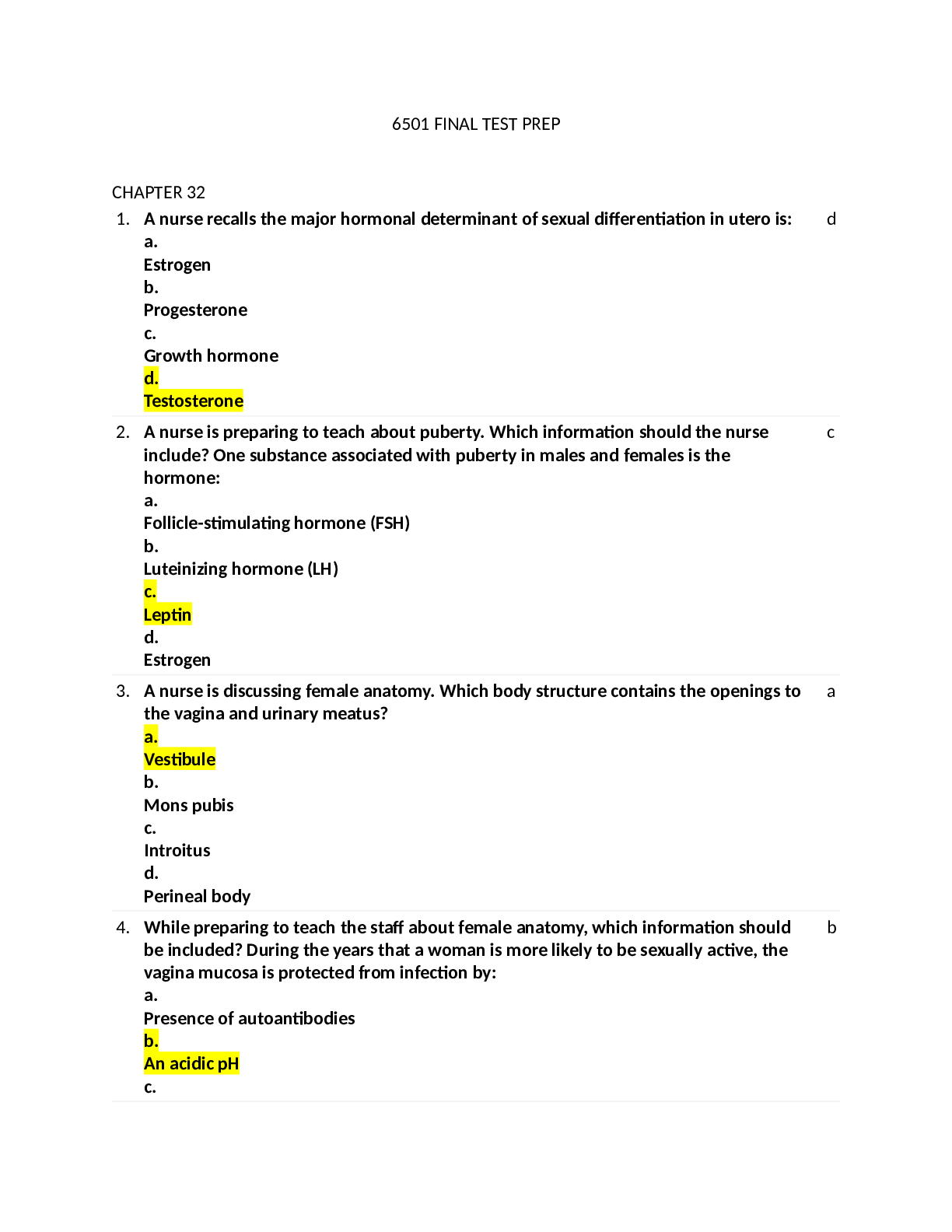
Reviews( 0 )
Document information
Connected school, study & course
About the document
Uploaded On
Mar 27, 2021
Number of pages
352
Written in
Additional information
This document has been written for:
Uploaded
Mar 27, 2021
Downloads
0
Views
38

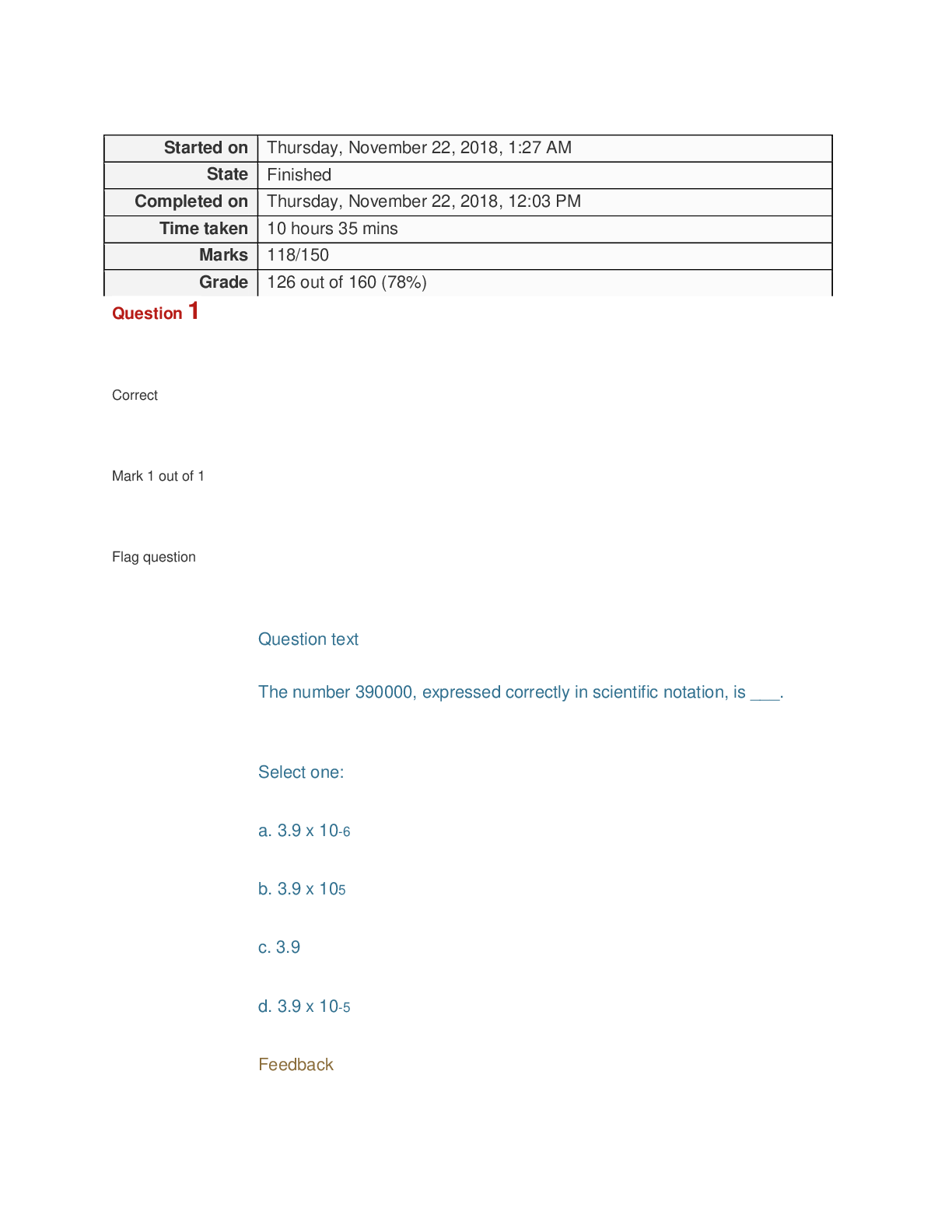
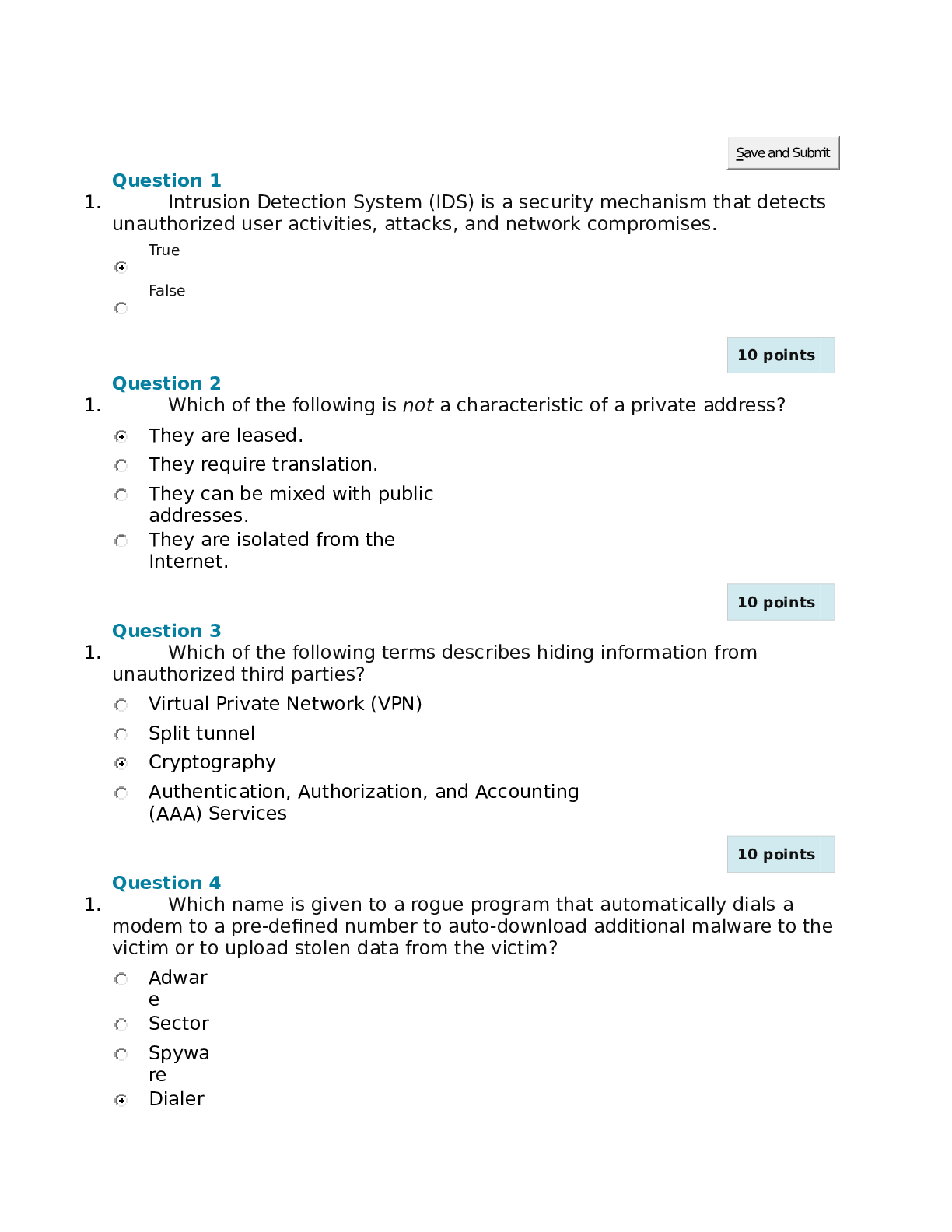

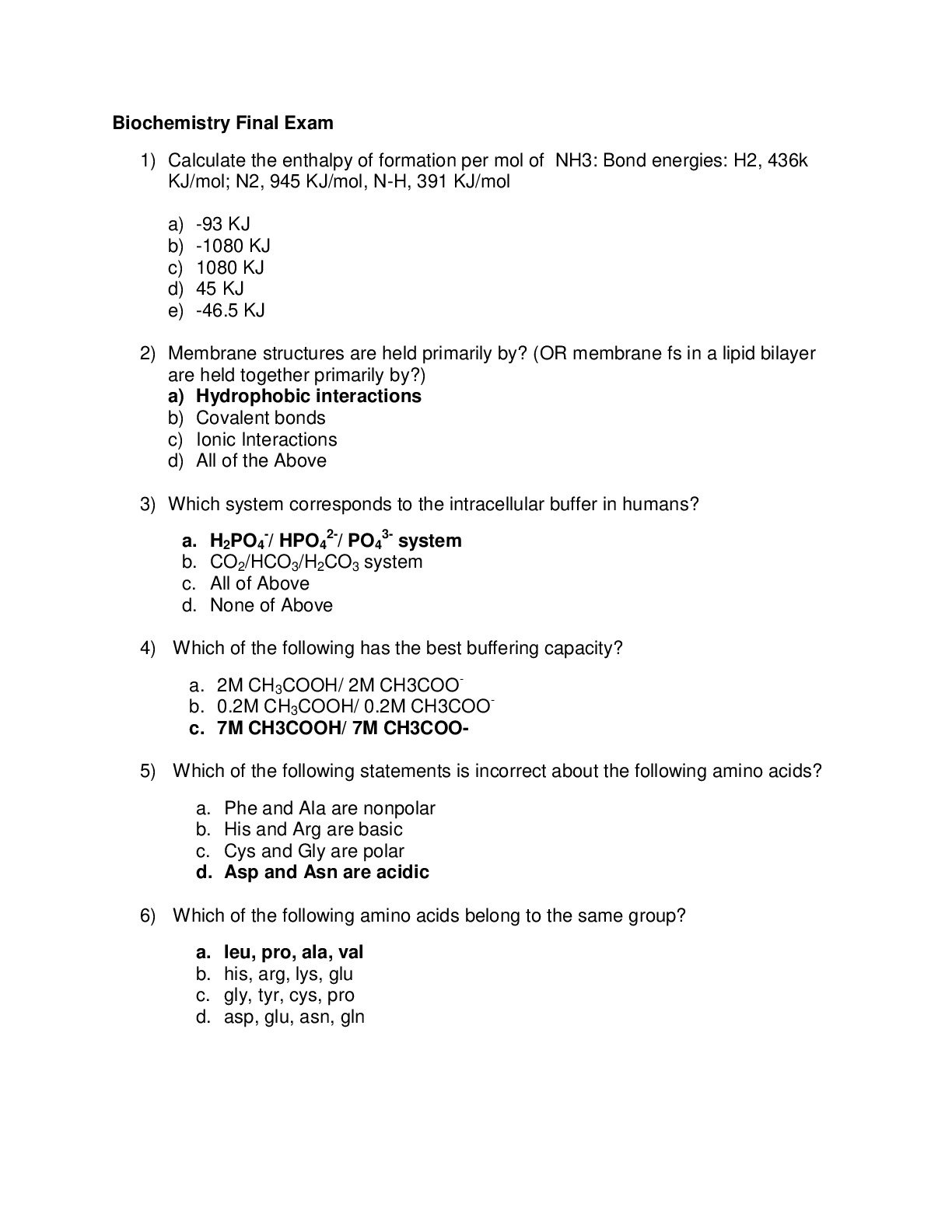
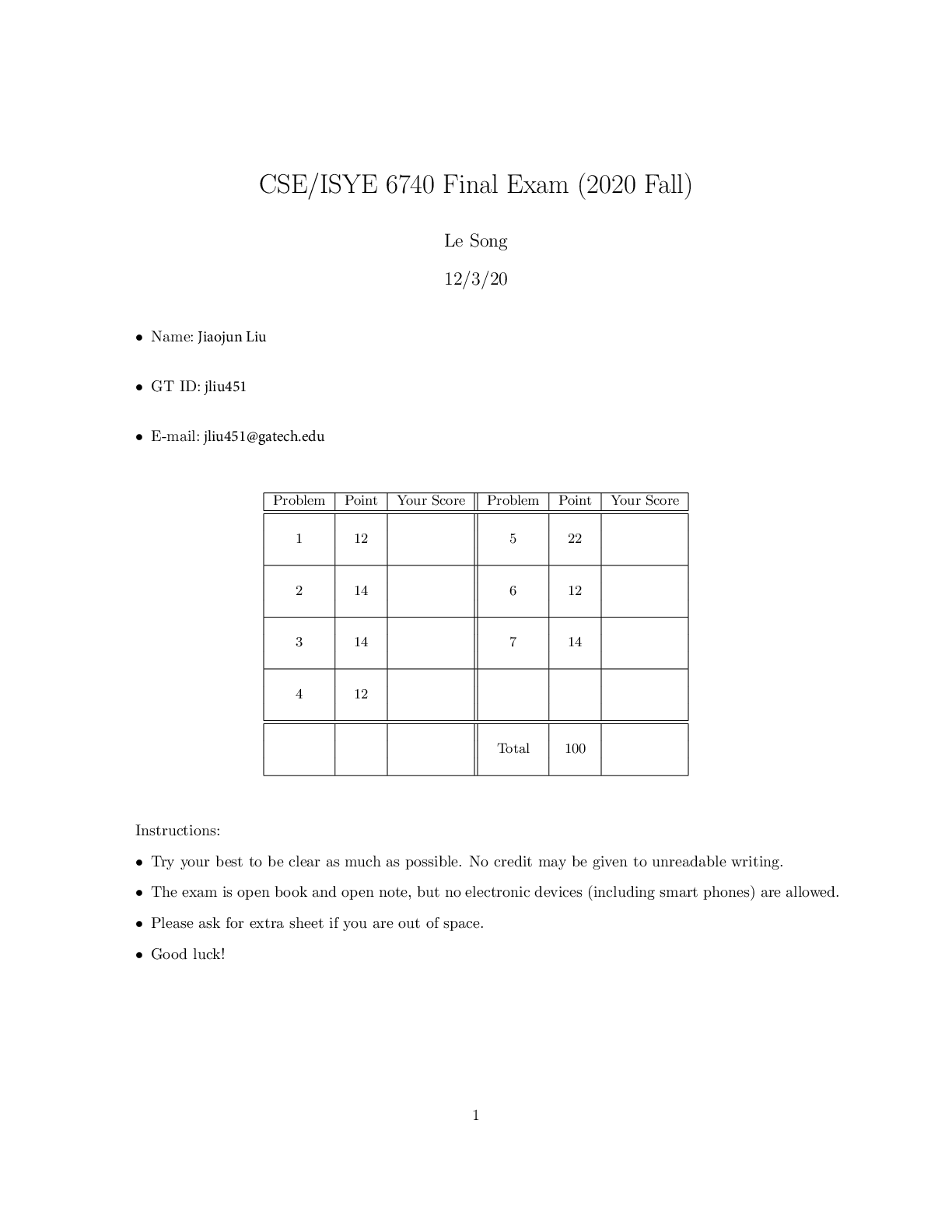
ddtete3.png)

